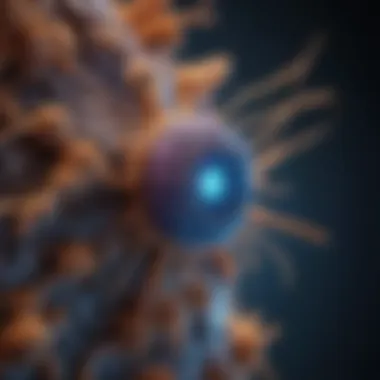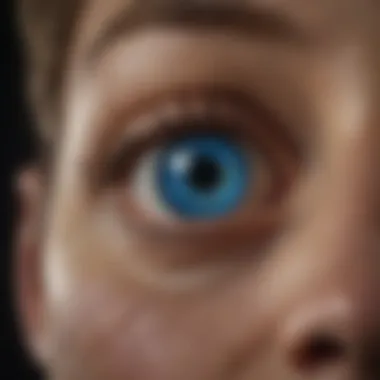Unlocking the Potential of UV Light for Germ Detection: A Comprehensive Insight


This article delves into the innovative use of UV light technology as a tool for detecting germs. By exploring the principles behind UV light and its effectiveness in germ detection, readers will gain a deeper understanding of this cutting-edge approach to sanitation and hygiene.
Synthesizing UV Light Technology with Germ Detection
In the realm of sanitation and hygiene, a revolutionary tool has emerged - UV light technology. Its exceptional ability to spot hidden germs has shifted the paradigm of hygiene practices. By harnessing the strengths of UV light, researchers and practitioners are unlocking a new era in detecting and combating harmful pathogens.
Illuminating the Science Behind UV Light
UV light operates on a wavelength not visible to the human eye, yet its impact in germ detection is profound. Understanding the mechanisms through which UV light interacts with germs is fundamental to appreciating its efficacy. The science behind UV light's germ-detecting prowess unveils a world of microscopic warfare, where the invisible becomes visible under its enlightening beams.
Advancing Sanitation Practices through UV Light
To grasp the full potential of UV light technology in germ detection is to comprehend the transformative power it holds for sanitation practices. By embracing UV light as a frontline defense against germs, we not only enhance hygiene standards but also redefine our approach to public health. The integration of UV light in germ detection heralds a new dawn in safeguarding against unseen threats.
Introduction to UV Light Detection
Understanding UV Light
UV Spectrum Overview
The UV spectrum overview stands as a foundational element in comprehending UV light detection. It delineates the various wavelengths within the UV spectrum, ranging from UV-A to UV-C, each with distinct properties influencing their interactions with microorganisms. The comprehensive nature of UV spectrum overview provides a crucial framework for harnessing the germicidal potential of UV light in diverse applications.
Types of UV Light
The categorization of UV light into distinct types, namely UV-A, UV-B, and UV-C, underscores the nuanced characteristics that differentiate each variant. While UV-A and UV-B find applications in cosmetic and medical fields, UV-C's germicidal properties are prominently featured in sanitation procedures, emphasizing its indispensable role in detecting and combating germs effectively.
Impact on Microorganisms
The impact of UV light on microorganisms represents a pivotal aspect of UV light detection. UV light's ability to disrupt the DNA of bacteria, viruses, and other pathogens underscores its unparalleled germicidal efficacy. By elucidating the mechanisms through which UV light inhibits microorganism growth, this segment underscores the transformative impact of UV technology on enhancing hygiene standards.
Germ Detection Techniques


Traditional Methods vs. UV Light
A comparative analysis between traditional germ detection methods and UV light reveals the unparalleled advantages offered by UV light detection. While traditional methods may fall short in reliably detecting hidden germs, UV light's ability to penetrate surfaces and identify microbial presence with high precision showcases its superiority in ensuring thorough sanitation protocols.
Advantages of UV Light Detection
The advantages of UV light detection lie in its non-invasive, rapid, and highly effective germ detection capabilities. Unlike traditional methods that often require time-consuming processes and may yield inaccurate results, UV light detection provides a swift and accurate means of spotting germs, bolstering hygiene practices across diverse settings.
Significance in Hygiene Practices
Role in Disease Prevention
UV light detection's role in disease prevention is characterized by its proactive approach in targeting germs at their source. By integrating UV technology into hygiene practices, the spread of infectious diseases can be mitigated effectively, safeguarding public health and fostering a hygienic environment conducive to well-being.
Applications in Healthcare Settings
The applications of UV light detection in healthcare settings are instrumental in bolstering infection control measures. From disinfecting medical equipment to sanitizing hospital environments, the efficacy of UV light in eradicating pathogens underscores its indispensable role in enhancing patient safety and reducing healthcare-associated infections.
UV Light Technology Features
In this section, we will delve into the crucial aspects of UV Light Technology Features within the context of detecting germs. UV light technology plays a fundamental role in this article as it serves as the cornerstone for germ detection mechanisms. Understanding the specific elements, benefits, and considerations regarding UV Light Technology Features is essential for comprehending the efficacy of UV light in germ detection.
UV Light Devices
Portable UV Lamps
Portable UV lamps are a vital component of UV Light Technology Features. These lamps contribute significantly to the ability to detect germs efficiently. Their key characteristic lies in their portability and ease of use, making them a popular choice for on-the-go germ detection. The unique feature of portable UV lamps is their ability to emit UV light at varying wavelengths, allowing for targeted disinfection. While portable UV lamps offer versatility and convenience, they may have limitations in terms of coverage area compared to larger UV devices.
UV Light Sterilizers
UV light sterilizers play a crucial role in germ detection by providing a high level of disinfection. Their key characteristic is their ability to kill a broad spectrum of microorganisms efficiently. This makes UV light sterilizers a preferred choice for ensuring thorough sanitation in various settings. The unique feature of UV light sterilizers is their advanced technology that utilizes UV-C light to penetrate and disinfect surfaces effectively. While UV light sterilizers excel in sterilization, they may require specific handling protocols to prevent exposure to skin and eyes.
UV- Disinfection Units


UV-C disinfection units represent a pinnacle in germ detection technology. Their key characteristic is the use of UV-C light at a specific wavelength known for its germicidal properties. This makes UV-C disinfection units a popular choice for industries requiring stringent disinfection standards. The unique feature of UV-C disinfection units is their ability to target and eliminate harmful pathogens effectively. While UV-C disinfection units offer unmatched disinfection capabilities, they necessitate caution due to the potential health risks associated with UV-C exposure.
UV Detection Mechanisms
Fluorescence under UV Light
Fluorescence under UV light is a critical aspect of UV detection mechanisms. This process involves the emission of light by certain substances when exposed to UV radiation. The key characteristic of fluorescence under UV light is its ability to reveal hidden contaminants that may not be visible under normal lighting conditions. This feature makes fluorescence a valuable tool in identifying germs and other particulate matter. However, the unique feature of this mechanism is its reliance on specific compounds or materials that exhibit fluorescence, limiting its applicability in all scenarios.
Microbial Growth Inhibition
Microbial growth inhibition is another essential UV detection mechanism that focuses on preventing the proliferation of microorganisms. By inhibiting microbial growth, UV light technology can effectively control the spread of germs and pathogens in various environments. The key characteristic of microbial growth inhibition is its ability to disrupt cellular processes in microorganisms, thereby halting their reproduction. This unique feature allows UV light to serve as a proactive measure against germ contamination. However, it is important to note that microbial growth inhibition may not be sufficient for instant germ detection and eradication, requiring continuous exposure to UV light for optimal results.
UV Safety Measures
Protective Gear
Protective gear is a fundamental aspect of ensuring safe usage of UV light technology. The key characteristic of protective gear is its ability to shield individuals from harmful UV radiation during germ detection processes. This makes protective gear an essential choice for maintaining personal safety in UV light-intensive environments. The unique feature of protective gear is its diverse range of options, including gloves, goggles, and protective suits, tailored to specific UV exposure scenarios. While protective gear offers paramount protection, users should be aware of the limitations in coverage and the need for proper maintenance and inspection to uphold safety standards.
Guidelines for Safe Usage
Guidelines for safe usage of UV light technology are imperative to prevent potential risks associated with UV exposure. By following established guidelines, users can minimize the chances of adverse effects from UV radiation during germ detection procedures. The key characteristic of these guidelines is their comprehensive approach to outlining proper procedures for handling UV devices and maintaining a safe working environment. The unique feature of these guidelines is their adaptability to different settings, ensuring standardized safety practices across various industries. While guidelines for safe usage promote safety, users should stay informed about updates in safety protocols and adhere to recommended practices to mitigate any hazards effectively.
Practical Applications of UV Light
In the comprehensive exploration of UV light’s capabilities in germ detection, the section on Practical Applications of UV Light plays a crucial role. This segment delves into the tangible ways in which UV light technology is utilized to detect and eliminate harmful germs. By focusing on specific elements such as UV Inspection Lamps and UV Light Sanitizers, readers gain insight into the practical benefits of incorporating UV light into hygiene protocols.
UV Detection Devices
UV Inspection Lamps
UV Inspection Lamps are an essential tool in the realm of germ detection, as they offer a portable and efficient method of uncovering hidden pathogens. Their key characteristic lies in the ability to illuminate surfaces with UV light, highlighting areas where germs may be present. This feature is particularly beneficial for this article as it enhances the discussion on practical applications of UV light by showcasing the technology's effectiveness in pinpointing microbial contamination. The unique aspect of UV Inspection Lamps is their ability to reveal fluorescent markers left by certain bacteria, aiding in targeted sanitation efforts. While UV Inspection Lamps are highly beneficial for germ detection, it is essential to note that prolonged exposure to UV light can have harmful effects on human health, emphasizing the importance of following safety guidelines.
UV Light Sanitizers


Another integral component in the practical application of UV light for germ detection is the use of UV Light Sanitizers. These devices provide a hands-free solution for disinfecting various surfaces by emitting UV-C light to eliminate pathogens. The key characteristic of UV Light Sanitizers is their ability to sanitize large areas quickly and effectively. This feature aligns with the main goal of this article by highlighting the convenience and efficiency of UV light technology in promoting hygienic practices. A unique feature of UV Light Sanitizers is their automatic shut-off mechanism when human presence is detected, ensuring user safety. Despite their advantages in sanitization, UV Light Sanitizers may pose a risk if not used correctly, underscoring the importance of proper training and adherence to safety measures.
UV in Everyday Life
The section on UV in Everyday Life sheds light on how UV light technology transcends traditional sanitization practices to become an integral part of daily hygiene routines. By focusing on UV Light for Surface Disinfection and UV for Air Purification, this segment underscores the versatility and applicability of UV light beyond specialized settings.
UV Light for Surface Disinfection
UV Light for Surface Disinfection offers a non-toxic and chemical-free method of eliminating germs from various surfaces. A key characteristic of this application is its ability to target specific areas with precision, making it a suitable choice for germ-infested environments. The unique feature of UV Light for Surface Disinfection is its ability to deactivate pathogens by disrupting their DNA, ultimately rendering them harmless. While the advantages of this technology are evident in promoting clean surfaces, potential disadvantages include the requirement for direct exposure to UV light, necessitating caution during operation.
UV for Air Purification
UV for Air Purification plays a vital role in maintaining clean and sterile indoor environments by neutralizing airborne pathogens. The key characteristic of UV for Air Purification is its ability to target mold, bacteria, and viruses present in the air, contributing to improved air quality. This makes it a popular choice for this article as it emphasizes the significance of UV light in enhancing overall hygiene standards. A unique feature of UV for Air Purification is its continuous operation capability, ensuring ongoing purification without interruptions. Despite its advantages in air sanitization, UV for Air Purification may have limitations in treating larger spaces efficiently, requiring strategic placement for optimal efficacy.
This detailed exploration of Practical Applications of UV Light showcases the diverse ways in which UV technology is revolutionizing germ detection and hygiene practices, providing readers with a comprehensive understanding of its implementation and impact.
Future Prospects and Innovations
In the realm of UV light technology and its innovative applications, focusing on future prospects and innovations is paramount. This section delves into the dynamic landscape of advancements that are shaping the future of UV light technology and its implications in germ detection and sanitation practices. By exploring the evolving trends and cutting-edge developments, readers can grasp the exciting potential that lies ahead in harnessing UV light for germ detection and beyond.
Advancements in UV Technology
Nano-Enhanced UV Filters
Nano-enhanced UV filters represent a significant leap in UV technology, offering enhanced precision and efficacy in germ detection and sterilization processes. These filters incorporate nanotechnology to improve UV light filtration, resulting in a more targeted approach to detecting and eliminating germs. Their key characteristic lies in the ability to operate at a molecular level, ensuring thorough disinfection and germ eradication in various settings. Nano-enhanced UV filters stand out for their exceptional capacity to target microscopic pathogens effectively, making them a pivotal choice for germ detection initiatives. Their unique feature lies in their ultrafine filtration capability, which enables thorough disinfection without leaving any room for microbial survival. The advantages of nano-enhanced UV filters in this context are evident, as they offer unparalleled precision and efficiency in detecting germs, thereby elevating hygiene standards to new heights.
Smart UV Detection Systems
Smart UV detection systems epitomize the fusion of technology and innovation in germ detection mechanisms. These systems are equipped with intelligent sensors and real-time monitoring capabilities, revolutionizing the way germs are identified and neutralized. The key characteristic of smart UV detection systems lies in their automated functionality, enabling seamless detection and response to microbial threats. Their ability to integrate data analytics and AI algorithms enhances the precision and speed of germ detection, making them a preferred choice for advanced sanitation solutions. The unique feature of smart UV detection systems is their adaptability to diverse environments, ensuring comprehensive germ detection across various sectors. While the advantages include improved accuracy and rapid response to emerging germs, potential disadvantages may involve initial setup costs and maintenance requirements. Nevertheless, the invaluable benefits they offer in enhancing germ detection efficiency make them indispensable in modern sanitation protocols.
Research Developments
UV Applications in Agriculture
The integration of UV technology in agriculture signifies a paradigm shift in crop protection and yield enhancement. UV applications in agriculture focus on harnessing UV light for pest control and disease management in crops, thereby reducing the reliance on chemical pesticides. The key characteristic of UV applications in agriculture is their non-toxic nature, posing minimal harm to the environment and human health. They are a beneficial choice for sustainable farming practices, promoting eco-friendly solutions for crop protection. The unique feature lies in their ability to target specific pests and pathogens, providing a targeted and effective approach to agricultural challenges. The advantages of UV applications in agriculture include reduced chemical usage, minimized environmental impact, and enhanced crop quality. However, potential disadvantages may involve limited efficacy in certain pest scenarios and specific crop varieties. Overall, the positive impact of UV applications in agriculture on sustainable farming practices underscores their significance in the agri-tech sector.
UV in Water Treatment
The utilization of UV technology in water treatment processes heralds a breakthrough in purifying water resources and ensuring safe drinking water supplies. UV in water treatment focuses on eradicating harmful organisms and contaminants present in water, rendering it potable and free from pathogens. The key characteristic of UV in water treatment lies in its disinfection efficiency, as UV light effectively inactivates bacteria, viruses, and other microorganisms that compromise water quality. This makes it a popular choice for water treatment facilities and public health initiatives. The unique feature of UV in water treatment is its non-chemical disinfection method, which eliminates the need for additives or by-products in the purification process, ensuring clean and safe drinking water. The advantages of UV in water treatment are manifold, including rapid disinfection, minimal maintenance requirements, and environmentally friendly operation. Despite these benefits, potential disadvantages may involve high energy consumption and limited effectiveness against certain contaminants. Nonetheless, the contribution of UV in water treatment to water sanitation and public health underscores its importance in ensuring access to clean water resources.







